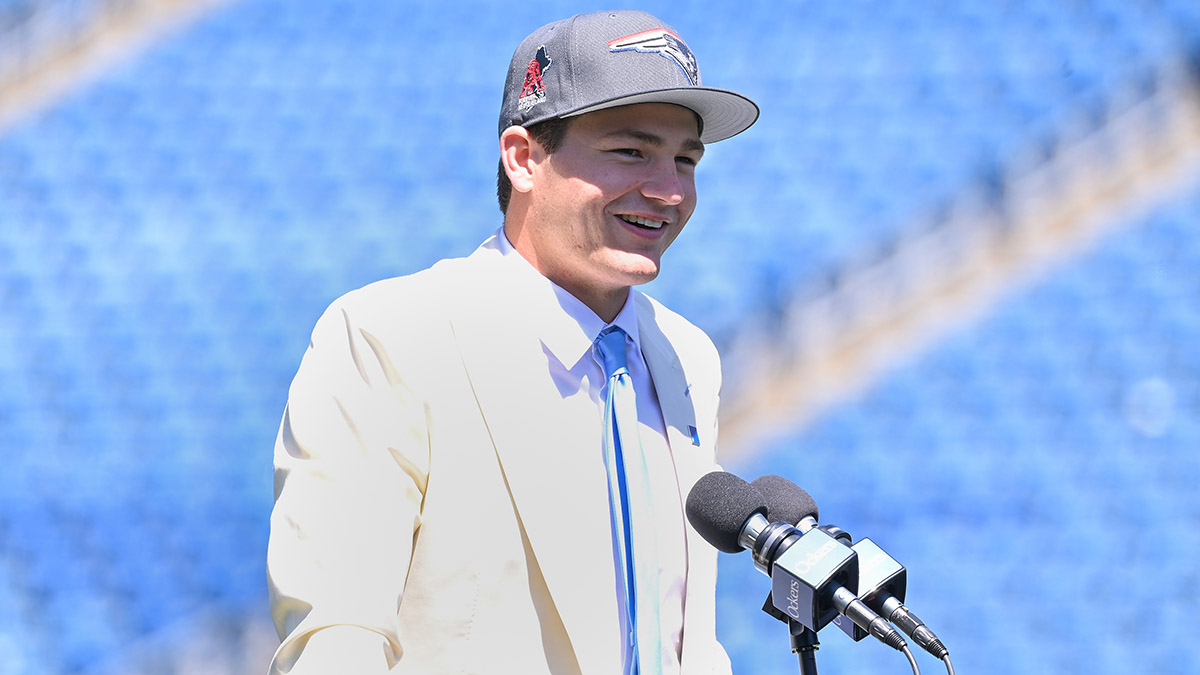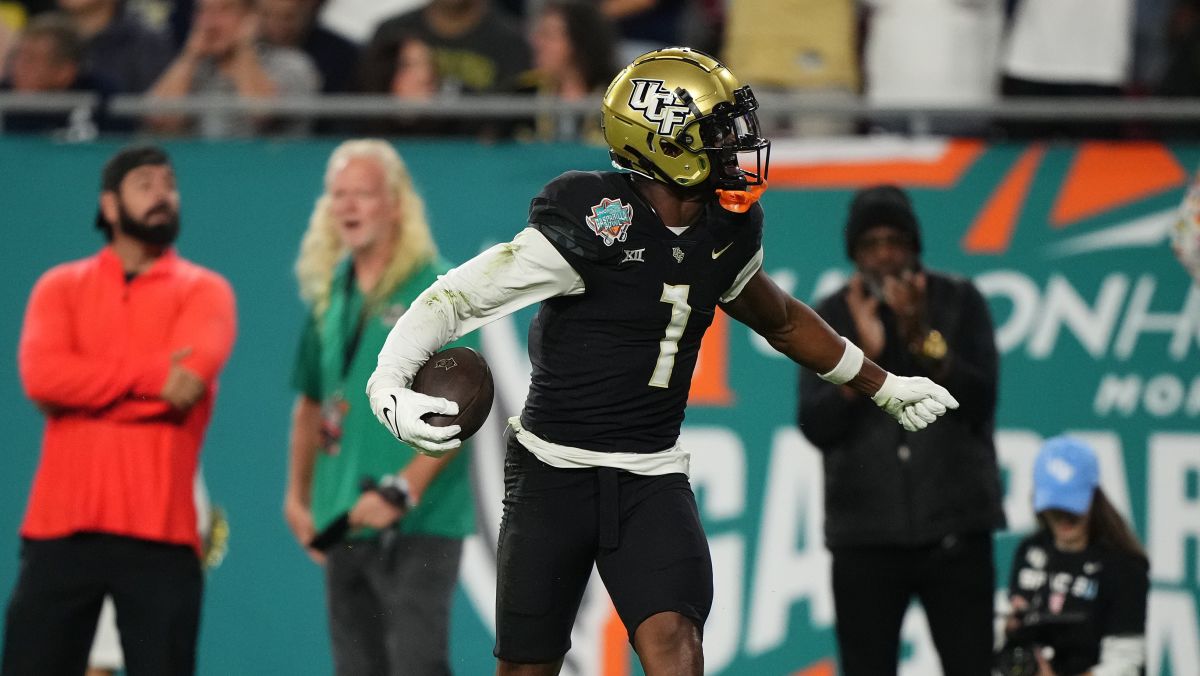The Patriots were in dire need of whatever receiving help they could get in this year's draft class.
In spite of their desperation for something -- anything -- that would help their passing game, they were able to come away with two players whose skill sets seem to be tailored to fit the abilities of New England's No. 3 overall pick, Drake Maye.
"Obviously," Patriots de facto general manager Eliot Wolf told the team's website soon after making the Maye pick on Thursday night, "Drake's a really good downfield thrower."
Stay in the game with the latest updates on your beloved Boston sports teams! Sign up here for our All Access Daily newsletter.
Of the top three quarterbacks taken in this year's draft, none had more yards on completions of passes that traveled 20 yards or more down the field than Maye over the last two years (2,667 compared to 2,398 for Caleb Williams and 1,864 for Jayden Daniels).
Maye was tops among the top three when it came to Pro Football Focus' big-time-throw metric -- which records downfield passes with excellent accuracy and timing -- with 66 since 2022. That exceeded the number of big-time throws for both Williams (44) and Daniels (38). And that Maye accumulated that volume of deep-and-accurate completions with just six turnover-worthy plays is indicative of some polish in that area.
The Patriots didn't end up adding a burner to capitalize on Maye's deep-passing abilities, necessarily. But they did get two receivers -- one on Day 2 and one on Day 3 -- who have shown an ability to make explosive plays down the field and could complement Maye's strengths.
MORE PATRIOTS COVERAGE
Second-round wideout Ja'Lynn Polk finished last season with a 99.9 deep-receiving grade from Pro Football Focus in Washington's downfield passing offense. He picked up 39.6 yards per catch on 22 targets of 20 yards or more down the field, and he was eighth in the draft class in yards per route run on those deep shots. He didn't drop a deep pass all season, and he snagged five of his eight contested down-the-field targets.
Fourth-round pick Javon Baker, meanwhile, ended up with a 98.3 deep-receiving from PFF. He averaged 38.2 yards per catch on those shots -- deep throws made up 35.2 percent of his overall targets -- and he was 10th in the class in yards per route run on throws of 20 yards or more. He dropped just one of his 25 deep targets, and he snared four of his six contested throws deep.
Baker, in particular, is someone accustomed to working down the field and scouts consider him to have a better shot at playing the "X" position. An eye-opening 77 percent of his targets last season (55 of 71) traveled at least 10 yards beyond the line of scrimmage, and he has more than a handful of acrobatic down-the-field grabs on his tape.
"Just come to the home stadium and bring your popcorn," Baker told reporters after being selected. "I make people in wheelchairs stand up."
Polk, meanwhile, while capable down the field, may be best suited to function in another role as a pro. One league executive compared Polk to Jakobi Meyers. Another NFL evaluator compared him to Tyler Boyd. Both are work-the-middle types of players as opposed to true deep threats.
"Smart, tough," one offensive assistant said of Polk. "He's not a No. 1. He's not an 'X.' He tracks the ball well down the field, he's just not a blazer speed-wise. You'll want him off the ball. He'll work the middle of the field. He's just a good football player. I like him."
"Strong contested-catch guy," texted one AFC executive after Polk was drafted. "Not a ton of RAC. High character."
Of Polk's 87 targets last season, 58 came in the short (0-9) or intermediate (10-19) range. On 37 catches in that area, he picked up 459 yards, an average of 12.4 yards per catch.
Among receivers drafted in this class, he was 10th in the class with 10 forced missed tackles last season, and he was eighth in the draft class in terms of yards per reception against man coverage. He's comfortable working in tight spaces, fighting for extra yards, and doing some of the dirty work in the crowded areas of the field that not all wideouts are fond of doing.
Another number suggesting Polk thrives in traffic? His most efficient spot on the field as a pass-catcher last year was in the intermediate center of the field -- between the numbers and between 10-19 yards down the field -- where he racked up a quarterback-rating-when-targeted figure of 135.7.
How does that mesh with Maye? He just so happened to be one of the most aggressive middle-of-the-field passers in this draft class.
Over the last two seasons, No. 2 overall selection Jayden Daniels attacked the center of the field with intermediate and deep targets 105 times. No. 1 pick Caleb Williams threw to that area 131 times. Maye targeted that same range a whopping 180 times.
Maye has been efficient, too -- especially in the intermediate middle -- suggesting that he and Polk may be able to find an early connection there.
Last season, Maye had 48 attempts in the intermediate middle, picking up 11.1 yards per attempt and an adjusted completion percentage of 70.8. Williams (9.7 yards per attempt, 61.2 adjusted completion percentage) fell short of Maye in both categories.
Over the last two seasons, Maye's numbers exceed Daniels' in that same area. The LSU product posted 767 yards on 44-of-75 passing (59 percent), for 10.2 yards per attempt, with nine touchdowns and just two picks. Extremely effective. But not quite as good as Maye, who accumulated 1,369 yards on 70-for-113 (62 percent), for 12.1 yards per attempt, with 11 touchdowns and one pick in that area.
"I think Drake Maye is one of the best middle-of-the-field throwers I've ever seen in college football," PFF's Steve Palazzolo told Next Pats prior to the draft. "As far as the feel of throwing a seam route, throwing the ball around defenders, throwing with touch, layering it -- the middle of the field is outstanding."
Cynthia Frelund, analytics expert for NFL Media, shared with Next Pats one number in particular that backed that up: Maye's intermediate completions had a speed variance -- showing his ability to layer targets to that area -- of about seven miles per hour. Over the last three seasons, Power Five quarterbacks had an average speed variance of about half that (3.4).
"He attacks the middle of the field," Nate Tice of The Athletic told the GoJo and Golic podcast earlier this offseason. "I think that is the 3-pointer for quarterbacks. It's where the YAC is. It's where the juiciest areas are. But it's also the hardest area to attack. And he does it already."
In Polk and Baker, the Patriots might not have landed one of the consensus future-No.-1-wideouts in this draft class. But they nabbed two players whose skill sets could end up getting the best out of New England's new face-of-the-franchise quarterback.



